Introduction
The modern internet often feels like an uncontrolled storm: memes born and buried in hours, absurdities circulating faster than facts, serious political protests masked as jokes, and a cultural language that values randomness over reason. To many, it looks like a collapse of meaning. But in truth, it’s part of a much older pattern.
Long before Wi-Fi and smartphones, early 20th-century artists warned — and celebrated — the very forces now defining online culture. Movements like Dadaism, Fluxus, and early glitch art rejected traditional structures, mocked authority, embraced chaos, and treated absurdity not as failure, but as a statement.
Far from being irrelevant footnotes of art history, they predicted the exact landscape we now navigate daily — a world where nonsense can be weaponized, randomness creates belonging, and the breakdown of order becomes a form of cultural expression.
1. Dadaism: The Birth of Meaningless Protest
In the trenches of World War I, where millions died for reasons that even the victors struggled to explain, a group of artists asked an obvious but radical question:
If reason and logic led us here, what good are they?
Thus was born Dadaism, a movement that made absurdity its guiding principle. From Hugo Ball’s gibberish sound poems to Marcel Duchamp’s infamous urinal (Fountain), Dadaists aggressively rejected every standard of art, politics, and social order. They staged nonsensical performances, assembled random collages, and openly mocked the idea that human society was built on rational foundations.
In today’s digital culture, the echoes are deafening.
Meme culture thrives on deliberate nonsense. Popular formats often feature mangled text, surreal images, and humor so layered in irony that it resists easy decoding. "Shitposting" — sharing content that's intentionally low-quality, confusing, or contextless — is not a glitch in online culture; it’s a feature. It serves the same purpose Dadaists once intended: to disrupt, to destabilize, and to protest without being trapped by conventional forms.
When today’s teenagers make memes mocking the very idea of seriousness, when online communities rally behind slogans that are part in-joke and part battle cry, they are participating — knowingly or not — in a lineage that began when Dadaists decided that if the world made no sense, they would make even less.
2. Fluxus: Art Without Art
In the 1960s, another movement took Dada’s rebellion even further. Fluxus artists — among them George Maciunas and Yoko Ono — declared war on the entire concept of "art" as something separate from life. They staged "happenings" instead of exhibitions, encouraged audience participation over passive viewing, and insisted that the process of creation mattered more than any polished result.
Fluxus wasn’t interested in technical excellence. It wasn't even interested in recognizable art. It wanted to tear down the wall between artist and audience — to make creativity as common, messy, and imperfect as daily life itself.
Sound familiar?
Today’s internet is Fluxus at scale.
TikTokers improvising strange dances in their bedrooms,
YouTubers sharing half-edited vlogs,
Meme-makers remixing one another’s jokes in endless, low-fi variations —
This is not the elite, polished art world. This is creation as living action: constant, imperfect, participatory.
Virality itself owes a debt to Fluxus thinking. Content spreads not because it is technically superior, but because it sparks interaction — laughter, confusion, mockery, inspiration. The user is no longer a spectator but an essential collaborator in giving content its meaning, just as Fluxus intended.
In a world where a viral meme from a teenager with no art training can be seen by millions, the Fluxus dream has been realized — even if almost no one remembers the name.
3. Early Glitch Art: Beauty in Failure
The modern age worships technology — but it also revels in its failures.
Glitch art, emerging in the late 20th century, took digital mistakes — corrupted files, pixelated videos, distorted sounds — and made them beautiful. Artists found meaning not in smooth, polished outputs, but in the jagged imperfections where code faltered and chaos crept in.
Glitch art challenged the notion that technology was infallible. It argued, implicitly and sometimes explicitly, that in the cracks of our digital systems, we could glimpse something more human — the stubborn persistence of error, unpredictability, and even decay.
Now glitch aesthetics are everywhere:
In indie video games that deliberately pixelate and crash,
In album covers featuring digital static and distortion,
In Instagram filters that mimic broken analog cameras.
It’s not just a style. It’s a statement: Perfection is boring. Chaos is real.
Even culturally, glitch thinking has bled into distrust of "perfect" presentations — the polished corporate ad, the too-perfect influencer photo, the seamless political speech. Increasingly, audiences seek authenticity in visible imperfection, a sensibility first championed by those early glitch pioneers.
Thank you for your time today. Until next time, stay gruntled.
Do you like what you read but aren’t yet ready or able to get a paid subscription? Then consider a one-time tip at:
https://www.venmo.com/u/TheCogitatingCeviche
Ko-fi.com/thecogitatingceviche
















Share this post